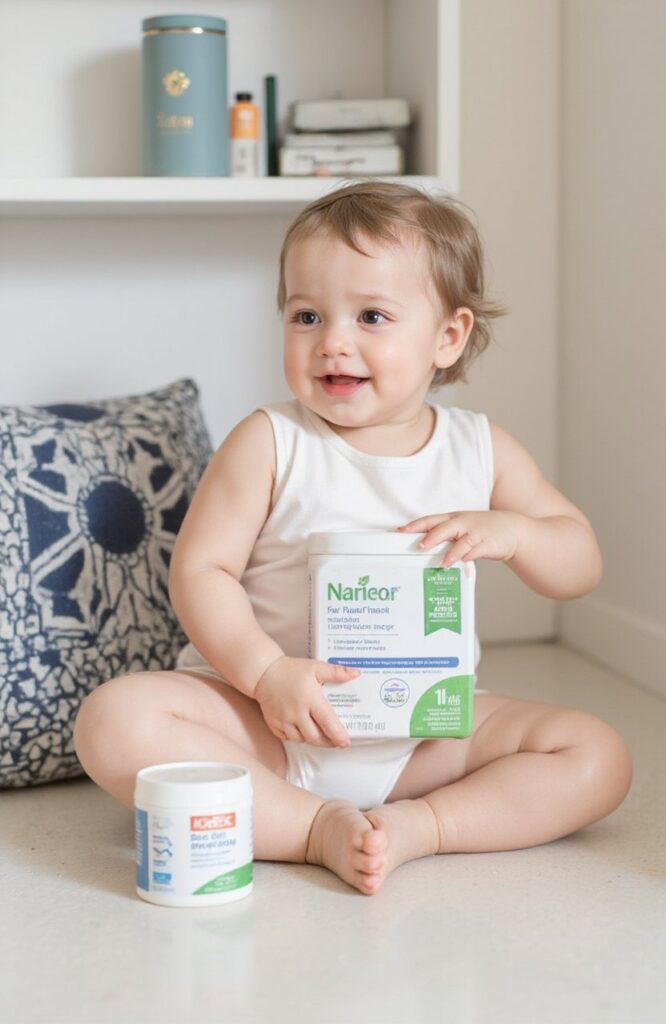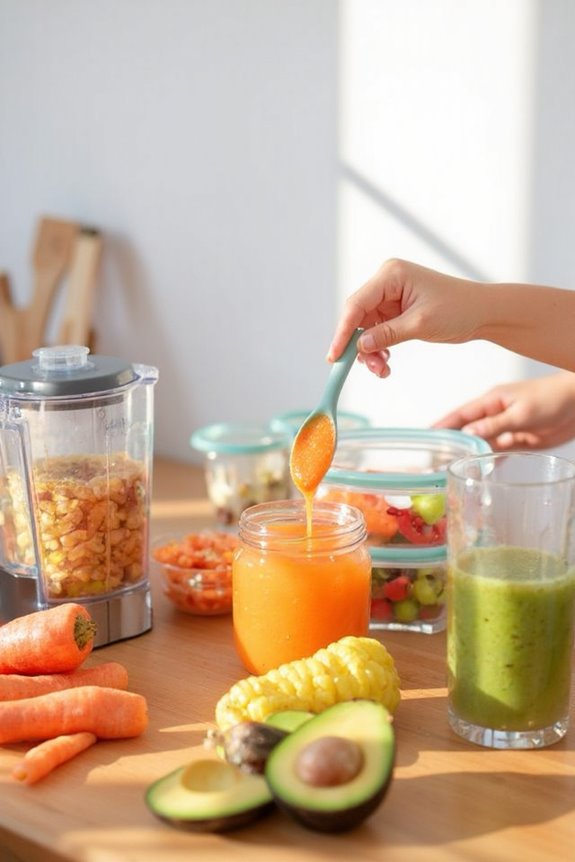The best baby formula depends on your child’s specific needs. Top options for 2025 include SMA Little Steps (budget-friendly), Bobbie (USDA Organic), and specialized formulas like Similac Sensitive for babies with digestive issues. Quality formulas should contain essential fatty acids (DHA/ARA), complete macronutrients, and key vitamins and minerals. I recommend consulting your pediatrician before choosing, as they can help identify which formula addresses your baby’s unique requirements. The sections below explore each option in greater detail.
Key Takeaways
- The best baby formula depends on your infant’s specific needs, with top options including SMA Little Steps, Bobbie, and HiPP.
- Organic formulas like Holle and HiPP meet strict EU standards and mirror breast milk’s protein ratio and nutritional content.
- Specialized formulas address sensitive tummies and allergies, with options like Similac Sensitive (lactose-free) and hypoallergenic varieties.
- Budget-friendly options like SMA Little Steps provide complete nutrition without premium pricing while meeting regulatory standards.
- Look for formulas containing essential fatty acids (DHA/ARA), complete macronutrients, key vitamins, minerals, and prebiotics/probiotics.
Top-Rated Baby Formulas for 2025
Five exceptional baby formulas have emerged as industry leaders in 2025, offering parents reliable nutrition options for their little ones. When comparing top rated brands, SMA Little Steps stands out for its excellent value and quality ingredients, making it a trusted all-rounder for daily use.
For newborns specifically, First Infant Baby Powder Formula provides appropriate nutrition with easy preparation. If you’re seeking alternatives to cow’s milk, Nannycare offers a premium goat’s milk formula suitable for special dietary requirements.
For parents on the go, HiPP Pre-mixed Formula provides convenience without sacrificing quality. These formula comparisons show that each option serves different needs:
- SMA Little Steps: Best overall value
- First Infant: Ideal for newborns
- Nannycare: Top goat’s milk alternative
- HiPP: Most convenient pre-mixed option
Organic and Natural Formula Options

While conventional baby formulas meet nutritional standards, organic and natural options have gained significant traction among health-conscious parents seeking cleaner alternatives. I’ve found several standout choices in this category:
Brands like Bobbie, which is USDA Organic certified, emphasize clean ingredients and organic sourcing from pasture-raised cows. Their formula has earned the Clean Label Project Purity Award and contains naturally occurring fats that reduce the need for added plant oils.
European options such as Holle and HiPP adhere to strict EU organic standards with:
- Milk from biodynamic or grass-fed cows
- No palm oil (using more sustainable fat sources)
- Lactose as a natural sweetener instead of corn syrup
- Climate-positive farming practices
These formulas typically mirror breast milk’s protein ratio and meet EU standards for DHA and iron.
Specialized Formulas for Sensitive Tummies and Allergies

Many parents discover that their baby needs more than a standard formula when issues like frequent spit-up, excessive gas, or allergic reactions emerge. Specialized formulas provide targeted solutions for these concerns.
For sensitive digestive systems, lactose-free options like Similac Sensitive and Enfamil Sensitive can reduce fussiness and gas. These contain easy-to-digest carbohydrates that replace lactose.
For babies with allergies, look for:
- Hypoallergenic formulas with hydrolyzed proteins
- Amino acid-based formulas for severe allergies
- Products with allergy-friendly ingredients like extensively hydrolyzed proteins
Brands like HiPP Organic and Bobbie Organic Gentle incorporate prebiotics and probiotics to support gut health. Earth’s Best Organic Sensitivity contains immune-supporting DHA alongside prebiotic fibers.
These specialized formulas maintain complete nutrition while addressing specific sensitivities.
Budget-Friendly Quality Formulas That Don’t Compromise

Parents seeking affordable formula options don’t need to sacrifice quality for cost. My research shows that budget options like SMA Little Steps (priced around £8 per tin) offer complete nutrition at a fraction of premium brands’ cost.
When comparing affordable nutrition options:
- Budget formulas meet the same regulatory standards as expensive alternatives
- Most contain lactose as the primary carbohydrate, similar to breast milk
- Testing reveals minimal heavy metal content across price points
SMA Little Steps and similar brands offer notable benefits:
- Plant-based DHA from algae for brain development
- No clumping when mixing
- Halal certification
- Free from fish and palm oil
- Fully recyclable packaging
Unlike subscription-based premium brands, these formula options remain widely available in supermarkets and online retailers, providing reliable access without premium pricing.
Key Nutritional Components to Look for in Baby Formula
Understanding what’s in your baby’s formula can feel overwhelming, but I’ve analyzed dozens of products to identify what truly matters.
When evaluating formulas, I recommend focusing on these essential components:
- Essential fatty acids – Look for DHA, ARA, LA, and ALA, which support brain development and vision
- Complete macronutrients – Guarantee balanced proteins, fats, and carbohydrates that mimic breast milk proportions
- Vitamin importance – Prioritize formulas with adequate Vitamins A, D, E, K, and C for immune function and growth
- Critical minerals – Check for calcium, iron, and phosphorus for bone and blood development
- Prebiotics/probiotics – Consider formulas with GOS or beneficial bacteria that support gut health
The FDA regulates minimum levels for 30 nutrients and maximum limits for 9, guaranteeing baseline safety for all commercial formulas.
Frequently Asked Questions
When Should I Switch From Formula to Cow’s Milk?
Did you know 90% of pediatricians recommend waiting until 12 months? I suggest starting your cow’s milk shift around your baby’s first birthday when their digestive system is ready. This supports proper toddler nutrition.
Can I Mix Different Formula Brands if Needed?
I’d say yes, you can mix different formula brands if needed. Formula compatibility between major brands is generally good, but watch for digestive issues. When brand switching, try to changeover gradually for smoother adaptation.
How Long Can Prepared Formula Safely Sit at Room Temperature?
Like milk left in a summer picnic basket, prepared formula won’t stay fresh long. I’d recommend following room temperature guidelines: don’t leave it out for more than two hours, or one hour after baby starts feeding.
Should Formula Be Warm or Cold When Feeding Baby?
I recommend serving formula lukewarm, as most babies prefer this temperature. While cold formula is safe, many infants reject it. Test formula temperature preferences on your wrist before feeding—warm, never hot, is ideal for baby feeding practices.
Is Homemade Baby Formula Ever a Safe Alternative?
I’ve seen cases where babies developed severe malnutrition from homemade formulas. I must caution that homemade ingredients can’t guarantee the nutritional balance infants need. Commercial formula is always safer—homemade alternatives are never recommended.





